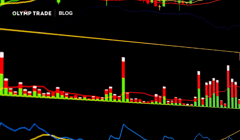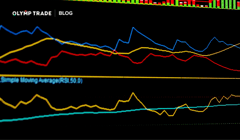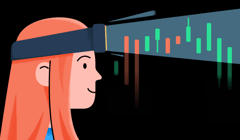
First introduced to the financial markets in 1995 by early market psychology pioneer Bill Williams, the Alligator indicator signals a trend’s absence, formation and direction.
Why did Williams name this indicator after a predator? Because of its three moving averages set for 5, 8 and 13 periods that represent the jaw, teeth and lips of an alligator. In this article, we discuss the Alligator indicator’s function, use and features, and show how it looks on a chart.
Contents:
- About the Alligator indicator
- Calculation formula
- Using the indicator
- The Alligator strategy
- Eye of the gator
Interact with the underlined words and green dots to get additional details and explanations.
Additional context for the visuals.
Explanations and definitions of terms.
About the Alligator indicator
The Alligator indicator uses three smoothed moving averages set at 5, 8 and 13 periods.
The three moving averages comprise the Jaw, Teeth, and Lips of the Alligator, opening and closing in reaction to evolving trends and trading ranges:
- The Lips is a smoothed 5-period moving average, moved by 3 bars into the future.
- The Teeth is a smoothed 8-period moving average, moved by 5 bars into the future.
- The Jaw is a smoothed 13-period moving average, moved by 8 bars into the future.
As the longest moving average, the Jaw shows how much an asset’s price should be if no other factors are influencing it. It is a long-term analog of a fair market value, which is why it’s called the “Balance Line.”
As long as the asset price is above the Jaw, the market is continuously moving upwards. Conversely, if the price is lower than the Jaw, the market tends to go down.
Bill Williams called the moving averages Balance Lines. If they are all crossed, he said, the Alligator is sleeping. And the longer it sleeps, the hungrier it gets. Williams pointed out that after the Alligator has woken up after a long period of sleep, it is quite hungry and starts chasing the price until it is full. Once it’s full, the distance between the moving averages decreases and they converge into narrow bands again, signaling the end of the trend 🐊
Calculation formula
The Alligator indicator is calculated as follows:
Median Price = (High + Low) / 2
Alligator’s Jaw = SMMA (Median Price, 13, 8)
Alligator’s Teeth = SMMA (Median Price, 8, 5)
Alligator’s Lips = SMMA (Median Price, 5, 3)
Median Price
The value in the middle of the data set, with half of the prices higher and half lower.
High
The maximum value of the price.
Low
The minimum value of the price.
SMMA
A smoothed moving average composed of three indicators: data to be smoothed, the smoothing period and a shift to the future.
Alligators Jaw
The Jaw line.
Alligators Teeth
The Teeth line.
Alligators Lips
The Lips line.
The value of the SMMA is calculated as a simple moving average (SMA). The main difference is that closing prices are not summed up, but rather the Median Price, the formula for which is shown above.
The second and subsequent moving averages are calculated by the following formula:
SMMAi = (Sum1 – SMMAi–1 + Median Pricei ) ÷ N
Where:
SMMAi
The smoothed moving average of the current bar (except for the first bar).
Sum1
The sum of the Median Price for N periods, counted from the previous bar.
SMMAi-1
The smoothed moving average of the previous bar.
Median Pricei
The median price of the current bar/candle.
N
The period.
Using the indicator

Consolidation. Alligator is sleeping.
The emergence of trade is possible. Alligator opens his mouth.
Bearish trend. Alligator’s mouth is open.
Price consolidation. Alligator closes his mouth.
If the indicator balance lines are interlaced, as in the figure above, we have a flat market.
If Alligator lines are approximately parallel to each other, directed downward, and the price chart is below these lines, the trend is descending and sell trades should be conducted.
If Alligator lines are approximately parallel to each other, directed upward, and the price chart is above these lines, the trend is ascending and it is worthwhile to make a buy trade.
Signals that can be obtained from the Alligator indicator
1️⃣ The strength of subsequent movement in the market
This can usually be determined by the amount of time the moving average lines are in an intertwined state. The longer that time, the larger the subsequent trend movement will usually be.
2️⃣ Signals preparing to enter the market
If during a trading range, the amplitude of fluctuations of moving averages begins to increase and the space between the lines slightly grows, it means that a new trend is most likely beginning.
3️⃣ To determine a trend
If the Alligator’s Jaws is furthest away from the price chart, Teeth is in between and Lips is closest to the price chart, the market is trending. The further these lines are from each other, the stronger the trend. The trend ends when the moving averages start to cross prices and each other.
The Alligator indicator is not usually used alone for market entry signals. Usually, the signal to buy is reflected by an upward movement in the Alligator indicator breaking through a fractal or is in combination with signals from other indicators.
The Alligator strategy
The main disadvantage of the Alligator indicator, as well as of any trend indicator, is its delay. Indicators of this type give signals when the trend has already begun to form, which can lead to having lost most of the trend movement by the time the signal is received.
Bill Williams himself suggested using this tool with other methods of analysis, such as fractals and the Gator Oscillator. The author suggested opening a trade when the amplitude of fluctuations in the moving averages increases. The Gator Oscillator can accurately determine the magnitude of a divergence in the balance lines.
As a signal for entering the market, Bill Williams advised to use not the Alligator indicator but a fractal breakthrough, located above or below the moving averages. In any case, regardless of whether you use the original trading strategy or create your own based on this indicator, we recommend testing it out before using it in the market.
Read more: Basics of trendline strategy
Eye of the gator
The Alligator indicator is an effective trading tool, the effectiveness of which has been tested by its developer and thousands of other traders. For both experienced traders and those new to trading, the Alligator strategy can be mastered with enough practice. To get the most out of your trading experience, we recommend using the Alligator indicator in combination with other indicators and technical analysis.
Join Olymp Trade and develop your trading skills. Our hundreds of trading assets, plethora of tools and informative blog are all at your service. Plunge into the world of finance and realize your potential with Olymp Trade!
Try out the Alligator IndicatorRisk warning: The contents of this article do not constitute investment advice, and you bear sole responsibility for your trading activity and/or trading results.
Bill Williams (1932–2019) was an American trader who developed a number of original analysis schemes based on the chaos theory in trading and developed several indicators. Moreover, he authored bestselling books on trading and found the prestigious trading school Profitunity Trading Group.
A technical analysis tool that uses certain algorithms to analyze price performance and suggest its interpretation.
A trend is the overall direction of a market or an asset’s price.
The value in the middle of the data set, with half of the prices higher and half lower.
The maximum value of the price.
The minimum value of the price.
A smoothed moving average composed of three indicators: data to be smoothed, the smoothing period and a shift to the future.
A smoothed moving average composed of three indicators: data to be smoothed, the smoothing period and a shift to the future.
A smoothed moving average composed of three indicators: data to be smoothed, the smoothing period and a shift to the future.
The smoothed moving average of the current bar (except for the first bar).
The sum of the Median Price for N periods, counted from the previous bar.
The smoothed moving average of the previous bar.
The median price of the current bar/candle.
The period.
The Jaw line.
The Teeth line.
The Lips line.
Trend indicators are usually charted on a price performance chart and are interpreted based on how the price behaves against them. The result of their interpretation is usually a trend direction forecast.











